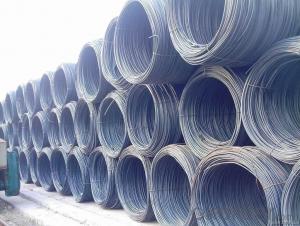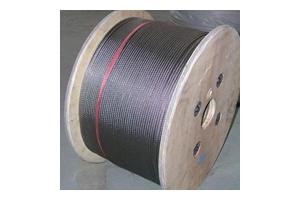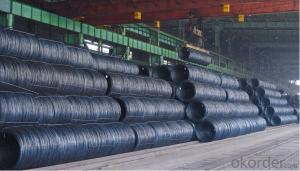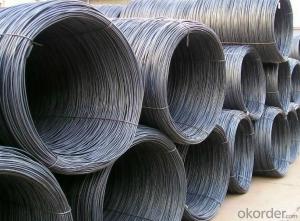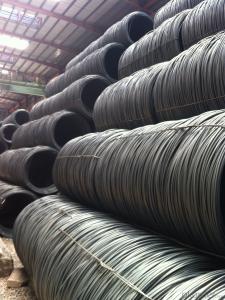American Wire rods with High Quality and Good Price
- Loading Port:
- Tianjin
- Payment Terms:
- TT or LC
- Min Order Qty:
- 25 m.t.
- Supply Capability:
- 20000 m.t./month
OKorder Service Pledge
OKorder Financial Service
You Might Also Like
Product Description:
OKorder is offering SAE1008 Wire Rods at great prices with worldwide shipping. Our supplier is a world-class manufacturer of steel, with our products utilized the world over. OKorder annually supplies products to European, North American and Asian markets. We provide quotations within 24 hours of receiving an inquiry and guarantee competitive prices.
Product Applications:
SAE1008 Wire Rods are ideal for structural applications and are widely used in the construction of buildings and the manufacturing, industries.
Product Advantages:
OKorder's Wire Rods are durable, strong, and resist corrosion.
Main Product Features:
· Premium quality
· Prompt delivery & seaworthy packing (30 days after receiving deposit)
· Corrosion resistance
· Can be recycled and reused
· Mill test certification
· Professional Service
· Competitive pricing
Product Specifications:
Manufacture: Hot rolled
Grade: SAE1006 – SAE1008
Certificates: ISO, SGS, BV, CIQ
Length: 6m – 12m, as per customer request
Packaging: Export packing, nude packing, bundled
Grade | Chemical Composition (%) | |||||
C | Mn | S | P | Si | B | |
SAE1006B | 0.03~O.07 | 0.32max | 0.045max | 0.040max | 0.30max | 0.0008min |
Mechanical properties | ||||||
Yield strength(N/mm2) | Tensile strength(N/mm2) | Elongation (%) | ||||
250-280 | 350-380 | ≥32 | ||||
Grade | Chemical Composition (%) | |||||
C | Mn | S | P | Si | B | |
SAE1008B | 0.10max | 0.3~0.50 | 0.050max | 0.040 max | 0.15max | 0.0008 min |
Mechanical properties | ||||||
Yield strength(N/mm2) | Tensile strength(N/mm2) | Elongation (%) | ||||
≥195 | 315-430 | ≥30 | ||||
FAQ:
Q1: How soon can we receive the product after purchase?
A1: Within three days of placing an order, we will begin production. The specific shipping date is dependent upon international and government factors, but is typically 7 to 10 workdays.
Q2: How do we guarantee the quality of our products?
A2: We have established an advanced quality management system which conducts strict quality tests at every step, from raw materials to the final product. At the same time, we provide extensive follow-up service assurances as required.
A3: Stainless does not "rust" as you think of regular steel rusting with a red oxide on the surface that flakes off. If you see red rust it is probably due to some iron particles that have contaminated the surface of the stainless steel and it is these iron particles that are rusting. Look at the source of the rusting and see if you can remove it from the surface.
Images:
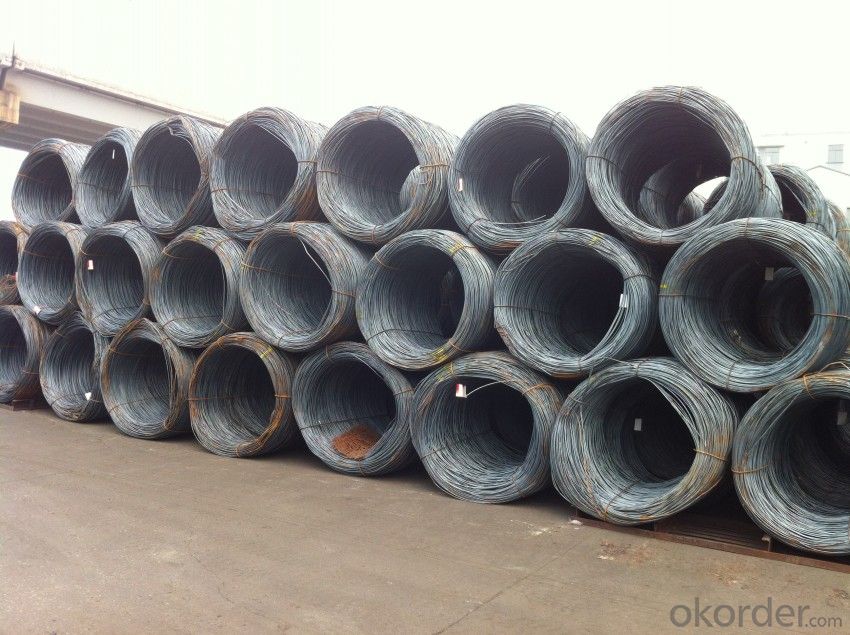
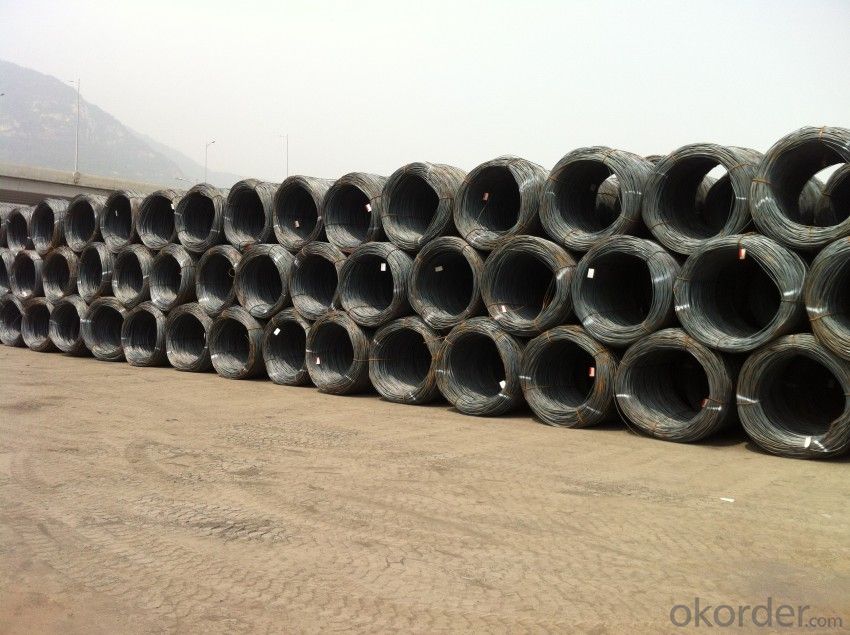
- Q: How is steel wire rod used in the manufacturing of wire for shipbuilding applications?
- Steel wire rod is used in the manufacturing of wire for shipbuilding applications as it serves as the primary raw material for producing high-quality wires. This wire rod is first drawn through a series of dies to reduce its diameter and increase its length, resulting in a thinner and longer wire. This wire is then further processed and fabricated into various components such as cables, ropes, and structural elements used in shipbuilding. The strength and durability of steel wire rod make it an ideal material for withstanding the harsh marine environment and ensuring the safety and reliability of ships.
- Q: What are the main factors influencing the choice of steel wire rod order refund policy?
- When determining the refund policy for steel wire rod orders, the satisfaction of customers, cost implications, and market competition all come into play. To begin with, customer satisfaction is a key factor in shaping the refund policy. By offering a refund policy, the company can address any concerns or dissatisfaction that customers may have with the product quality or other aspects of their order. This customer-centric approach demonstrates a commitment to resolving issues and ensuring a positive experience, which in turn fosters trust and loyalty. Ultimately, this can lead to repeat business and positive word-of-mouth. Additionally, the financial implications of refunds are an important consideration. Companies must carefully evaluate the potential costs associated with refunding orders, particularly when dealing with larger or more frequent refunds. It is essential to strike a balance between customer satisfaction and financial feasibility. In some cases, implementing certain conditions or limitations on refunds may be necessary to mitigate the financial impact. Furthermore, market competition influences the choice of refund policy. In a highly competitive market, refund policies can serve as a distinguishing factor that attracts customers. By offering a more lenient refund policy compared to competitors, a company can gain a competitive edge and attract and retain customers. Conversely, if competitors have stricter refund policies, it may be necessary for a company to align its policy accordingly to prevent customer loss. Ultimately, the decision regarding the refund policy for steel wire rod orders is a strategic one that takes into account customer satisfaction, cost implications, and the competitive landscape. Striking the right balance between these factors is crucial for the company's success in the industry.
- Q: What are the different storage methods for steel wire rod?
- The storage of steel wire rod varies depending on factors such as quantity, size, and condition. There are multiple methods available. One option is to stack the wire rod neatly and in an organized manner. This involves creating rows of wire rod coils on a stable surface like a concrete floor or a specially designed storage rack. It is crucial to stack the coils in a way that prevents rolling or collapsing for safety and easy access. Another method is to use wire rod racks or shelves. These racks are specifically designed to securely hold wire rod coils and prevent them from rolling or shifting. They often have dividers or compartments to keep each coil separate and well-organized. Vertical racks or stands can also be used, particularly when dealing with longer wire rod lengths. This method saves floor space by placing the rod vertically and securing it in place. For outdoor storage, designated areas with storage containers or shipping containers can be used. This provides protection from the elements and ensures the rod remains in good condition. Regardless of the chosen storage method, it is essential to protect the wire rod from moisture, dust, and other contaminants. This can be achieved by using plastic or metal covers or storing the rod in a climate-controlled environment. It's important to note that the specific storage method may vary depending on industry standards, regulations, and the specific requirements of the wire rod product. Consulting with industry experts or manufacturers is always recommended to determine the most suitable storage method for steel wire rod.
- Q: How is steel wire rod used in the manufacturing of suspension bridges?
- The manufacturing of suspension bridges heavily relies on steel wire rod, which is an essential component. These bridges mainly utilize it in constructing the main cables, which bear the most critical load. The main cables, responsible for supporting the weight of the bridge deck and transferring the load to the towers or piers, rely on the steel wire rod. To form the main cables, the steel wire rod is initially shaped into separate strands. The number of wires per strand varies depending on the bridge's size and load capacity, ranging from hundreds to thousands. These strands are then tightly wound around a central core. The strength and durability of the steel wire rod make it an ideal material for this purpose since it can withstand the immense tension and load placed on the bridge. Aside from the main cables, steel wire rod may also be utilized in other parts of suspension bridges, such as the hangers and suspenders. These elements connect the bridge deck to the main cables and aid in evenly distributing the load throughout the structure. Steel wire rod is selected for these applications due to its high tensile strength, excellent flexibility, and resistance to corrosion. Overall, steel wire rod plays a pivotal role in the manufacturing of suspension bridges. It provides the necessary strength, durability, and flexibility to support the structure and ensure its safe and efficient operation.
- Q: What are the main challenges in the steel wire rod industry?
- The operations and growth of the steel wire rod industry are impacted by several main challenges. To begin with, the volatility of raw material prices is one of the primary challenges. The industry heavily relies on inputs like iron ore and coal, and fluctuations in their prices can greatly affect profitability. This makes it challenging for companies to plan and forecast production costs. Additionally, intense competition is a struggle for the industry, both domestically and internationally. Many countries have a well-established steel wire rod industry, leading to oversupply and price wars. Manufacturers are under pressure to enhance production efficiency and reduce costs to stay competitive. Furthermore, environmental regulations and sustainability concerns pose another significant challenge. Steel wire rod production is energy-intensive and can result in emission of greenhouse gases and pollutants. Compliance with regulations and adoption of sustainable practices can add extra costs, requiring investments in new technologies and equipment. Moreover, meeting changing customer demands and preferences is a challenge for the industry. Customers now desire higher quality and customized steel wire rods that meet specific technical requirements. Manufacturers need to invest in research and development to develop new products and processes to meet these evolving needs. Additionally, the industry faces logistical challenges due to the heaviness and bulkiness of its products. Transportation costs can be high, especially for long-distance shipments, which impacts the competitiveness of manufacturers. Furthermore, the industry relies on a complex supply chain, and any disruptions or delays in the delivery of raw materials or finished products can have significant consequences for production schedules and customer satisfaction. Lastly, the steel wire rod industry is also vulnerable to economic cycles and global economic conditions. Slowdowns in construction and infrastructure projects, major consumers of steel wire rods, can lead to reduced demand and excess inventory. Economic downturns or trade disputes can also impact the industry's growth prospects and profitability. In conclusion, the steel wire rod industry faces various challenges, including volatile raw material prices, intense competition, environmental regulations, changing customer demands, logistical challenges, and economic fluctuations. Overcoming these challenges requires continuous innovation, improved efficiency, and adaptation to changing market conditions.
- Q: How are steel wire rods used in the production of reinforcements for concrete?
- Steel wire rods are a crucial component in the production of reinforcements for concrete. These wire rods are made from high-quality steel and are typically manufactured through a process called hot rolling. In the production of reinforcements for concrete, steel wire rods are used to create various types of reinforcements such as wire mesh, rebar, and welded wire fabric. These reinforcements are added to concrete structures to enhance their strength, durability, and resistance to cracking. To create wire mesh, steel wire rods are first straightened and then cut into desired lengths. These lengths are then welded together to form a grid-like pattern. The wire mesh is then placed within the concrete to provide tensile strength, preventing cracks from forming and spreading. Rebar, another common reinforcement, is created by bending and cutting steel wire rods into specific shapes and sizes. These rebars are then embedded within the concrete, providing structural support and reinforcing the concrete against tension forces. Rebars are commonly used in columns, beams, and slabs to ensure the structural integrity of the concrete structure. Steel wire rods can also be used to produce welded wire fabric, which consists of a series of intersecting steel wires. The wires are welded together at their intersections, forming a sturdy mesh. Welded wire fabric is often used in larger concrete structures such as bridges and highways to distribute loads and prevent cracking. Overall, steel wire rods play a vital role in the production of reinforcements for concrete. They provide the necessary strength, durability, and resistance to cracking, ensuring that concrete structures remain stable and long-lasting.
- Q: How is steel wire rod used in the manufacturing of wire cables?
- Steel wire rod is used as a raw material in the manufacturing of wire cables. It is first drawn through a series of dies to reduce its diameter and increase its strength. The resulting wire is then twisted or braided together to form cables of various sizes and configurations. The steel wire rod provides the necessary strength and durability to withstand the tension and stress that wire cables typically encounter in their applications.
- Q: What are the different types of wire mesh for architectural use made from steel wire rod?
- There are various types of wire mesh for architectural use made from steel wire rod, including welded wire mesh, woven wire mesh, expanded metal mesh, and perforated metal mesh. Each type offers different features and applications, providing architects with a range of options to suit their specific design requirements.
- Q: What are the common packaging materials used for steel wire rod coils?
- Packaging materials commonly employed for steel wire rod coils encompass wooden pallets, steel strapping, plastic wrapping, and metal sheets. Wooden pallets, serving as a foundation, are frequently utilized to stack and store the coils, ensuring stability and facilitating transportation. In order to prevent any movement or harm during transit, steel strapping is employed to firmly secure the coils together. To ensure the coils remain in prime condition, plastic wrapping is frequently employed to offer additional protection against moisture and dust. Occasionally, metal sheets are positioned atop the coils to provide supplementary safeguarding and prevent any external damage. These packaging materials are indispensable in guaranteeing the secure and efficient handling, storage, and transportation of steel wire rod coils.
- Q: How is steel wire rod used in the manufacturing of wire forms for safety barriers?
- Steel wire rod is a vital component in manufacturing wire forms for safety barriers. The process begins by selecting high-quality steel wire rod, typically made from carbon or alloy steel. This wire rod then goes through several manufacturing processes to produce wire forms that are strong, durable, and able to provide the required safety features. The first step in the manufacturing process involves drawing the wire rod. This entails pulling the wire rod through a series of dies to decrease its diameter and increase its length. Drawing is essential to ensure that the wire forms have a consistent diameter and a smooth surface finish. Once the wire rod is drawn, it is cut into the desired lengths for the wire forms. These lengths are determined based on the specific requirements of the safety barriers. The cut wire rod is then shaped into the desired form using techniques like bending, twisting, or welding. After shaping the wire rod, it is often coated or treated to improve its performance and durability. For instance, a galvanized coating can be applied to protect the wire form from corrosion and extend its lifespan. Additionally, the wire forms may undergo heat treatment processes to enhance their mechanical properties, including strength and hardness. The wire forms made from steel wire rod are then assembled into safety barriers. These barriers are used in various applications such as highways, construction sites, and industrial facilities to prevent accidents, control traffic, and provide security. The strength and durability of the wire forms enable the safety barriers to withstand impacts and offer effective protection. In conclusion, steel wire rod is crucial in manufacturing wire forms for safety barriers. It provides the necessary strength, durability, and stability required for these barriers to effectively protect people and property. The wire rod undergoes various manufacturing processes to create wire forms capable of withstanding impacts and delivering long-lasting performance.
Send your message to us
American Wire rods with High Quality and Good Price
- Loading Port:
- Tianjin
- Payment Terms:
- TT or LC
- Min Order Qty:
- 25 m.t.
- Supply Capability:
- 20000 m.t./month
OKorder Service Pledge
OKorder Financial Service
Similar products
Hot products
Hot Searches
Related keywords















